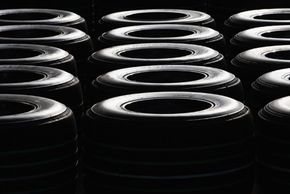Processing and Profiting from Rubber
How much rubber is bouncing around out there? According to the International Rubber Study Group, 9.7 million tons of natural rubber was produced in 2007, most of which came from Asia. At approximately $2,321 per ton, the natural rubber market involved about $22.5 billion in 2007 [source: International Rubber Study Group]. But before that natural rubber is transformed into stuff like hoses, rubber bands and little yellow ducks, it has to be processed.
Processing natural rubber consists of the following steps:
Advertisement
- Companies begin by obtaining the latex fluid, which means tapping the sap from the rubber trees, filtering the latex and then packaging it in drums for export or processing.
- They make smoked sheets of latex rubber. They clump the latex by adding acid, roll the clumped fluid into sheets in a mill to remove water, and then they dry, smoke and export the sheets.
- The latex is chemically treated and heated at low temperatures to prevulcanize it. Prevulcanized latex is easier to transport and can be converted to regular rubber later by gentle heating.
The profit and process picture is a little different for synthetic rubber. In 2007, about 13.6 Europe and Asia [source: International Rubber Study Group]. Priced at about $2,012 per ton, there was $26.2 billion to be made in the synthetic rubber market in 2007.
Synthetic rubber polymers are made from petroleum-based chemicals, clumped and dried for transport. Once at a manufacturing plant, the synthetic rubber polymers are mixed, ingredients may be added and the rubber is rolled into sheets. The sheets can be cut into strips for subsequent molding and processing. There are three basic processing techniques:
- Extrusion: Rubber polymers are heated and mechanically mixed in a long chamber, forced through a small opening and vulcanized or cured. This method is used to make large strands for compression molding.
- Injection molding: The rubber strips are heated and mechanically mixed in a chamber, forced under high pressure into a mold. The rubber is steam vulcanized in the mold and then cooled. Once cooled, the rubber product is released from the mold.
- Compression molding: The rubber strips are compressed around a mold under pressure and vulcanized to form to the mold. The cooled product is then removed from the mold.
Rubber may not be the first thing you think of when you think reduce, reuse, recycle, but some products can be recycled. For example, tires can be shredded and heated in an anaerobic environment (pyrolysis) to break down the rubber and to reclaim the oil as oil by-products such as benzene. In other recycling methods, shredded rubber can be compression molded into different products.
Don't leave the rubber room just yet. We have more links than you can shoot a rubber band at next.
Related HowStuffWorks Articles
More Great Links
Sources
- "Chewing Gum." From How Products Are Made, Vol. 1. (Sept. 26, 2008) http://www.madehow.com/Volume-1/Chewing-Gum.html
- "Latex." From How Products Are Made, Vol. 3. (Sept. 26, 2008) http://www.madehow.com/Volume-3/Latex.html
- "Recycling of Rubber." Practical Action. (Sept. 26, 2008) http://practicalaction.org/docs/technical_information_service/recycling_rubber.pdf
- "The Story of Rubber." Polymer Science Learning Center and the Chemical Heritage Foundation. 2000. (Sept. 26, 2008) http://www.pslc.ws/macrog/exp/rubber/menu.htm
- "The Strange Story of Rubber." Reader's Digest. 1957. (Sept. 26, 2008) http://www.goodyear.com/corporate/history/history_story.html
- "Tire." From How Products Are Made, Vol. 1. (Sept. 26, 2008) http://www.madehow.com/Volume-1/Tire.html
- American Chemical Society. "United States Synthetic Rubber Program 1939-1945." 2007. (Sept. 26, 2008) http://acswebcontent.acs.org/landmarks/landmarks/rbb/index.html#quest
- Bebb, R.L. "Chemistry of rubber processing and disposal." Environ Health Perspect. 17: 95-102, 1976. (Oct. 8, 2008) http://www.pubmedcentral.nih.gov/articlerender.fcgi?artid=1475270
- The Harboro Rubber Company. "Engineering in Rubber." (Sept. 26, 2008) http://www.harboro.co.uk/html/harboro5.asp
- The International Rubber Research and Development Board. "About Natural Rubber." Sept. 26, 2008 http://www.irrdb.com/irrdb/NaturalRubber/
- International Rubber Study Group. (Sept. 26, 2008) http://www.rubberstudy.com/default.aspx
- Kauffmann, G.B. "Charles Goodyear (1800-1860), American Inventor, on the Bicentennial of His Birth." Chem Educator 6: 50-54, 2001. (Sept. 26, 2008) http://www.springerlink.com/content/l6450m13167743lx/fulltext.pdf
- Kauffman, George B. "Rubber." Chemistry Foundations and Applications. (Oct. 8, 2008) http://findarticles.com/p/articles/mi_gx5216/is_2004/ai_n19132945
- Law, Laura. "Hevea brasiliensis: The Rubber Tree." Ethnobotanical Leaflets. Oct. 3, 1999. (Sept. 26, 2008) http://www.siu.edu/~ebl/leaflets/rubber2.htm
- Lehrman, Edward, M.D. "Selecting the right glove - understanding latex allergy and glove chemistry." Aug. 29, 1996. (Oct. 8, 2008) http://www.immune.com/rubber/nr3.html
- Loadman, John. "Everything you ever wanted to know about rubber." Bouncing Balls.com. (Sept. 26, 2008) http://www.bouncing-balls.com/index2.htm
- Loadmann, M.J.R. "The Exploitation of Natural Rubber." Malaysian Rubber Producer's Research Association. (Sept. 26, 2008) http://www.cementex.com/pdf/history.pdf
- New York Times. "The Romance of Rubber." Sept. 23, 1906. (Sept. 26, 2008) http://query.nytimes.com/mem/archive-free/pdf?_r=1& res=9805E6D61F3EE733A25750C2A96F9C946797D6CF&oref=slogin
- Rubber Development, Inc. "Rubber Technology 101." 2001. (Sept. 26, 2008) http://www.rubberdevelopment.com/download/tech.doc
- Snow, Richard F. "Charles Goodyear." AmericanHeritage.com. (Sept. 26, 2008) http://www.americanheritage.com/articles/magazine/ah/1978/3/1978_3_62.shtml
- VIP-Polymers. "Technology - Rubber Manufacturing." (Sept. 26, 2008) http://www.vip-polymers.com/rubber_manufacturing.asp
